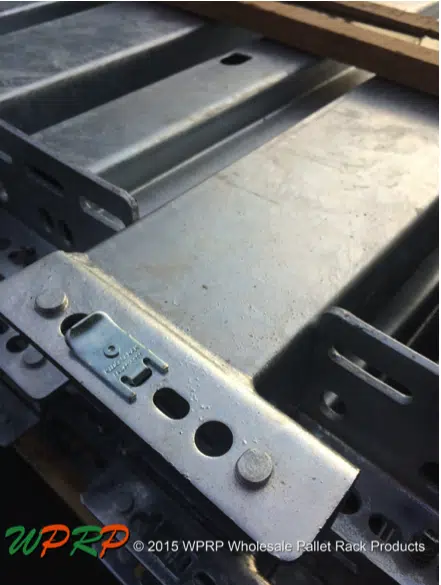Beam-to-Frame Connectors
This week’s #RackArt image is a cool perspective of a Ridg-U-Rak Pallet Rack beam-to-frame connector. Ear, beam-to-frame connectors, rivets — however you refer to them, they’re one of the primary components of a pallet rack cross beam. The structure and design of beam ears are often unique to the manufacturer and can determine the compatibility of the beam with various makes of upright frames. The design of a pallet rack beam-to-frame connector can also determine the types of safety clips (the upturned piece in the middle of the ear shown above) that can be used to keep the beams in place in the upright frames.
It’s common when trying to identify a beam to immediately look at the connector itself, and this can certainly be a viable means of beam identification. Ridg-U-Rak, for example, features a 2-pin connector on beams with profiles measuring from 2.5” to 5” in height. The number of pins on a connector can be effectively used as an identification criterion for the beam shown above, as many pallet rack manufacturers produce beams of the same size with 3-pin connections. Despite having one less pin on their ears, these beams offer the same and sometimes greater capacity than their 3-pin counterparts.
A beam identification strategy that is often overlooked is the use of the beam’s safety clip (assuming there’s one already attached) to pinpoint the beam’s manufacturer. The galvanized Ridg-U-Rak beam shown above, for example, is given away by the safety clip attached to its ear, which features a proprietary design. Sometimes, when there aren’t enough distinct features on the beam to be able to identify the manufacturer, or if the person trying to identify the beam is unfamiliar with pallet racking, the safety clip is the easiest way to narrow down the possibilities.
If one were to look at the beam towards the top of the picture, they could see that there is a small opening on the inside face of the beam. This opening is created specifically for the “claw” that pulls the beams along the production line. The hole allows the beam to be pulled forward for cutting.
At WPRP, our goal is to help you, and we want to make sure you’re in the know when it comes to pallet rack components and the different ways one can identify their racking.

